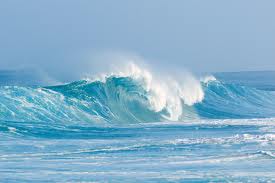Understanding the Waves 
The first rule of waves, especially in the open ocean, is that there are no rules. Kind of a hypocritical statement considering the intent of this, but it is a cold hard fact. There are simple physical factors that makeup the "normal" wave, but within the forces of nature, there a myriad of other factors that need be considered. Regardless, an understanding of what makes a wave can be of considerable benefit to the everyday sailor.
There are three factors that make up waves:
- Wind speed Length of time the wind has blown
- Distance of open water that the wind blows over; called fetch
All of these factors have to work together to create waves. The greater each of the variables in the equation, the greater the waves. Waves are measured by:
- Height (from trough to crest) Length (from crest to crest) Steepness (angle between crest and trough)
- Period (length of time between crests)
Waves are never created in one uniform height. Waves fall into a systemic pattern of varying size. Therefore, in order to classify wave height we determine the significant wave height, which is the average of the highest 1/3 of the waves in a system. This is how weather reports will specify wave height. Once you have the significant height, it is simple to determine the theoretical average height, the highest 10% and the highest wave sizes in a given area. Mathematically speaking, it's simple arithmetic based on predetermined ratios:
Average height | .64:1 |
Significant height | 1:1 |
Highest 10% | 1.29:1 |
Highest | 1.87:1 |
TYPES OF WAVES
Waves take their time to develop; they don't spontaneously erupt from the ocean. It takes a certain speed of wind to blow over a certain distance for a considerable length of time to create lasting waves.
There are three different types of waves that develop over time:
Ripples appear on smooth water when the wind is light, but if the wind dies, so do the ripples. Seas are created when the wind has blown for a while at a given velocity. They tend to last much longer, even after the wind has died. Swells are waves that have moved away from their area of origin and are unrelated to the local wind conditions -- in other words, seas that have lasted long beyond the wind.
The definition of swells can be a bit confusing when you understand that waves never actually go anywhere. The water does not travel along with the waves, only along with the current -- two mutually exclusive elements of water animation. If two people stand at either end of a long rope and undulate their arms up and down in an equal rhythm, waves will develop along the length of the rope that appear to move from one end to the other. The rope fibers aren't actually moving at all, other than up and down. This is exactly what is happening with waves. The speed, or velocity of the wave is measured by how long it would take a wave to pass a given point crest to crest -- say a line drawn on the ground beneath the rope. There is a slight movement of the water particles within a wave, Waves can be further described as:
A non-breaking wave, is a "normal" rolling wave. A breaking wave is one who's base can no longer support it's top and it collapses. Depending on the size, this can happen with considerable force behind it -- 5 to 10 tons per square yard. Enough force to crush the hull of a ship. When the ratio of steepness of a wave is too great, it must break. This happens when a wave runs into shallow water, or when two wave systems oppose and combine forces